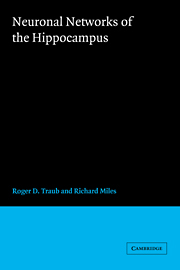Book contents
- Frontmatter
- Contents
- Acknowledgments
- Prologue
- 1 The hippocampus in context
- 2 Physiology of single neurons: voltage- and ligand-gated ionic channels
- 3 Synaptic function and organization of the CA3 region
- 4 The single-cell model
- 5 Model of the CA3 network
- 6 Collective behaviors of the CA3 network: experiment and model
- 7 Collective behaviors of the CA3 network: spontaneous oscillations and synchronized synaptic potentials
- 8 Field effects
- 9 Theoretical approaches: mathematical neural networks
- Conclusion
- Notes
- References
- Index
5 - Model of the CA3 network
Published online by Cambridge University Press: 05 February 2012
- Frontmatter
- Contents
- Acknowledgments
- Prologue
- 1 The hippocampus in context
- 2 Physiology of single neurons: voltage- and ligand-gated ionic channels
- 3 Synaptic function and organization of the CA3 region
- 4 The single-cell model
- 5 Model of the CA3 network
- 6 Collective behaviors of the CA3 network: experiment and model
- 7 Collective behaviors of the CA3 network: spontaneous oscillations and synchronized synaptic potentials
- 8 Field effects
- 9 Theoretical approaches: mathematical neural networks
- Conclusion
- Notes
- References
- Index
Summary
This chapter concerns our methods. How do we translate the available data on the cellular physiology of the CA3 region into a useful model of the circuitry? By “model,” we mean here a computer program. We must then consider how to organize and construct the computer program.
Specifically, we must decide the following: How many cells should we include, and of what types? How are the cells arranged in space? How can the communication between different cells be described? This last question is particularly complex, because it includes both functional and structural aspects. Functionally, we must model the transduction of soma membrane potential into axonal action potentials and axon conduction delays, and the transformation of arriving presynaptic impulses into postsynaptic conductance changes. Structurally, we must specify how the axonal outputs of each type of cell are distributed in space and how many synaptic inputs of each type (excitatory, GABAA, GABAB) each cell should have. We shall discuss these fundamentally physiological issues in turn and then analyze briefly how our simulation program actually works.
Cells
Types of cells. We use three basic types of cells: pyramidal cells (or e cells, for “excitatory cells”); inhibitory cells whose postsynaptic effect resembles that mediated by perisomatic GABAA receptors (i1 cells); a inhibitory cells whose postsynaptic effect represents that mediated by dendritic GABAB receptors (i2 cells).
- Type
- Chapter
- Information
- Neuronal Networks of the Hippocampus , pp. 104 - 118Publisher: Cambridge University PressPrint publication year: 1991



